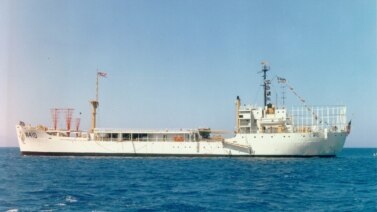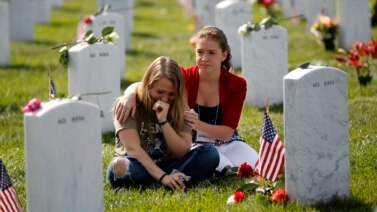The Cold War is long over. But there is still some clean-up to do, including cleaning up nuclear missiles.
The U.S. plans to reduce the total number of land-based nuclear missiles by 2018. This will satisfy terms of an arms treaty the U.S. signed with Russia in 2011.
The northern U.S. state of North Dakota has been a traditional home to many of those land-based missiles. It is a part of the state’s Cold War history that officials, residents, and visitors, enjoy.
North Dakota -- An Out-of-the-way State.
Far from densely populated cities on the most northern edge of the United States, was one of the most secretive and dangerous places on the planet for many years. The state is called North Dakota.
North Dakota’s distance from urban centers made it the perfect choice for a nuclear land-based missile site during the Cold War. The lives of millions depended on what happened with the deadly weapons stored there.

The Cold War was the name often used for the severe tensions between the United States and the former Soviet Union. And during that Cold War period, the name for this missile site was November-33. It was home to a long-distance missile with a nuclear warhead.
Alvin Jaeger is secretary of state in North Dakota.
“I think there was kind of a standing joke that North Dakota was actually the third largest power in the world in terms of the nuclear capacity that we had here.”
Mr. Jaeger grew up there in the 1950s. And he remembers the Cold War fears of a nuclear attack that would destroy everything.
Mr. Jaeger says there was reason to worry. More than 1,000 such missiles were deployed around the state. The people in North Dakota knew the missiles made them a good target.
“We all realized that we would have been a big target, but we just kept on.”
The Cold War is over. The nuclear threat is gone. But the keys are still by the starter control of the Oscar Zero Launch facility outside Cooperstown, North Dakota.
The U.S. Air Force retired Oscar Zero in 1998. This was part of the Strategic Arms Reduction Treaty 2 - or what is known as START 2. Now the Oscar Zero launch center is called the Ronald Reagan Minuteman Missile State Historic Site. It is a place where you can bring your family on vacation.
Gwen Hinman is supervisor at the Ronald Reagan Minuteman Missile Site. Ms. Hinman shows tourists around in the area below the surface. She takes them into the heart of the front line of the Cold War.
"The threat was high enough that they had their keys in the consoles."
Ms. Hinman shows visitors where a small crew would wait behind thick steel blast doors and reinforced concrete. They would wait for the decision to launch their nuclear missiles.
About 150 active missile centers remain in North Dakota, although Jaeger says few people know about them.
“Within 100 miles there is an active operating nuclear field that exists, and, again, people just go about their daily lives.”
The areas that are active facilities are closed to the public. But Gwen Hinman says they are not too different from Oscar Zero. She explains that they are off-line, meaning not connected to any computers.
This is a really good thing. It prevents hackers from launching a nuclear attack.
“It’s all offline so it prevents hackers from hacking the system and potentially sending a missile.”
Four-hundred-and-50 land-based nuclear missiles currently are spread across the United States. Earlier this year, the Pentagon approved a plan to remove 50 of those missiles from storage. This will bring the total down to 400. And that will be the lowest number since the height of the Cold War in the 1960s.
I’m Anna Matteo.
This story was written in Special English by Anna Matteo from a report by VOA reporter Kane Farabaugh.

